Special weapons
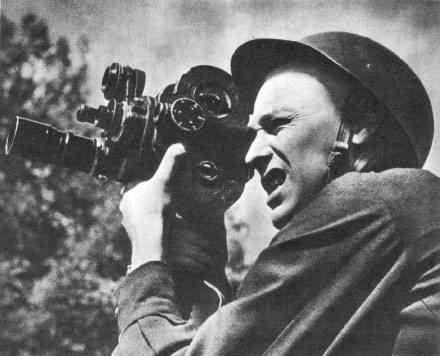
The fifteenth Oscar awards ceremony, held on 4 in March 1943, in Los Angeles, in the concert hall of the fashionable Ambassador Hotel, began with a sensation. For the first time the prestigious award of the American Film Academy was presented to a foreign film. In the new nomination for the best full-length documentary, the winner was the Soviet film “The defeat of the German troops near Moscow” by filmmakers Leonid Varlamov and Ilya Kopalin. The brass plate of the cherished statuette was stamped: "For the heroism of the Russian people in defending Moscow and for working on the film in conditions of extreme danger." The first domestic "Oscar" was the recognition of the courage, bravery and creative deed of the Soviet front-line cameramen during the war years, the main and special weapons which was a movie camera.
During the 1418 days of the war, risking their own lives, they shot 3,5 million meters of film, more 500 numbers of newsreels and releases, 101 documentary. To them we owe our living memory of that war - the Great Patriotic War ...
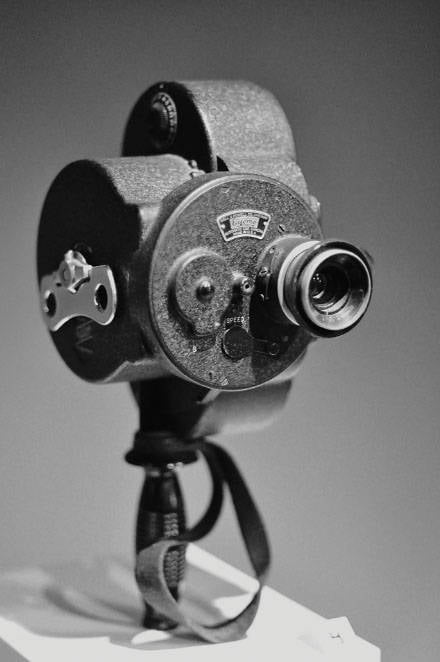
"Defense" topics
The birth of the Russian frontline newsreel occurred during the First World War. With the charity Skobelev Committee, which was under the highest patronage of Emperor Nicholas II, which was designed to assist sick and disabled soldiers, in 1914, a military cinema department was formed. He was supposed to be engaged in "the production of cinema tapes of military educational and educational content, designed specifically for soldier cinema, and battle paintings for the cinema market in general." The cameramen of the committee worked on the fronts, using up to 1916 exclusively the monopoly right to shoot military events. During the war years, the Russian Military Chronicle newsreel appeared on the screens.
The first shots of military newsreels, already taken 20 July 1914, were footage of the shelling of the Russian naval base Libau German cruisers "Augsburg" and "Magdeburg". These shots were shot by a young 17-year-old cameraman Eduard Tisse who turned out to be the director of all the films of Sergei Eisenstein and the founder of the Soviet camera school, who happened to be on the local beach.
Operators A. Digmelov, P. Ermolov, P. Novitsky, who continued their work under Soviet power, began their work on the fronts of the First World War. The text of the telegram from P. Novitsky to the editorial office of the Cineinfo newspaper has been preserved: “Warm greetings. While unscathed. For shooting under enemy fire on October 29, he was awarded George ... ".
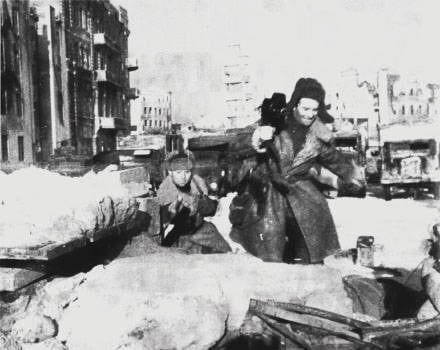
Working as bulky and cumbersome first stationary movie cameras, operators shot a lot of training and training personnel for soldiers, training battles, a lot of staged episodes and very few real combat actions. Therefore, such subjects as: “Field of exercises near the front” (1914), “Fall of Przemyshl” (1915), “Capture of Turkish cities by Russian troops” (1915), “Nikolay II in his headquarters in Mogilev” (1916).
The Soviet government quickly appreciated the propaganda capabilities of cinema, guided by Lenin's: "... of all the arts, cinema is the most important for us." The plots about the liberation of cities by the Red Army, rallies and parades have already compiled the chronicle of the Civil War. These were the short films “First Horse on the Front”, “Tsaritsyn Front”, “Black Days of Kronstadt”, which were shot by operators E. Tisse, A. Lemberg, F. Verigo-Darovskiy, V. Lemke.
But the real revolution in documentary filmmaking was the creation in 1928 by the American company Bell-Howell of the mobile camera film Aymo (Eyemo), which was not inferior in performance to the most modern for those times small-format cameras. The mobility of the camera made it possible to shoot in hard-to-reach places and extreme conditions, instantly change the shooting points and the scale of the image, i.e., as needed in a combat situation. Before the war, operator assistants worked mainly on Aimo - they were usually assigned to complete the filming of individual parts.
The use of new technology and the tide of young talented cadres in newsreels contributed to the appearance in the second half of 30 of the first small group of “combat”, “fired” operators specializing in military, or, as they said, defense topics. Documentary shots of hostilities shot by operators R. Carmen, V. Eshurin, B. Dobronitsky, S. Gusev, A. Shchekutev, B. Shtatland, A. Krichevsky, N. Bykov, S. Simonov, S. Fomin, F. Pechul , now we can see in the films "Abyssinia" (1936), "China in the fight" (1938), "Khalkhin-Gol" (1939), "Spain" (1939), "Liberation" (1940), "On the Danube" and Mannerheim Line (1940), the latter two paintings being awarded the Stalin Prize at 1941, and those participating in the filming were presented with high government awards.
And yet it must be admitted that these films, made by the social and propaganda order of the Stalinist elite, have contributed to making a fool of the population of the USSR, imposing hats and moods in the pre-war years.
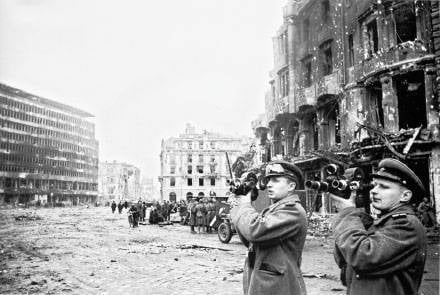
On the eve of the oncoming war, 25 in March 1941, a meeting of cinema workers on defense topics was held at the head of the Main Political Propaganda Directorate of the Red Army. As a result, an order was created to create a special camera group, which included V. Yeshurin, S. Kogan and V. Statewide All three were enrolled in the Red Army. 3 months before the start of the war ...
1941-th
The first to go to the front were “fired” operators who had combat experience. Behind them - volunteers 22 cinematographic graduate of the Faculty of Cameraman VGIK. The oldest Russian chronicler Peter Yermolov (he was already 54 of the year), and veterans of the Chelyusk epic experienced operators Mark Troyanovsky and Arkady Shafran, as well as operators of Moscow, Leningrad, Ukrainian and Belarusian newsreel studios got under the gun. Already 23 June was at the front of the first film group, and three weeks after the start of the war in the ranks of the Red Army there were more than 89 documentary filmmakers, united in 16 film groups.
8 July, the first front-line shooting appeared in Soyuzkinozhurnal No. 63 - “The Fascist Gang Will Be Destroyed” by operators Yeshurin and Kogan. Now all the results of camera work: front-line reports, essays, portrait sketches were included in the form of separate plots in the issues of “Soyuzkin magazine”, which came out twice a month from 1941 to 1944, with a total of more than 400 issues.
Soviet operators, accustomed to solemn parades on Red Square and the broadcast launches of industrial giants, were stunned by the truth of our defeat for 1941 of the year that had opened up to them. They found themselves in the face of national misfortune and terrible human losses, having gone through the bitter roads of retreat along with units of the Red Army. Roman Carmen will later write: “It is difficult, it was impossible to remove our grief, our losses. I remember that when I saw a Soviet plane shot down in front of my eyes, and when the corpses of the pilots were discovered, I didn’t take it off, I just didn’t take it off! My camera was in my hands, and I, choking on tears, looked at it, but did not take it off. Now I curse myself for it. ” It is not surprising that in the newsreel of the beginning of the war there were very few shots of our retreat, because the operators were trying to film heroism, and he, by the concepts of that time, had nothing in common with suffering, pain, and loss.
Fearless chroniclers rushed to the front to shoot in real combat conditions. Very quickly, however, it turned out that neither desperate bravery nor courage at the front was enough, there was a need for combat experience and an elementary military outlook. The operational situation was changing unpredictably, it was necessary to understand what was happening at the front. Many hostilities began early at dawn, or only at night, or even with the use of a smoke screen, which made shooting impossible.
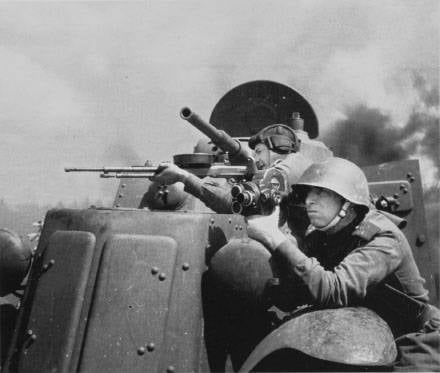
Operator Konstantin Bogdan recalled his first experience: “Fire, crashing. It was here that it dawned on me what it means to be an operator at the front. Everyone is sitting in the ground, only bullets and shells are flying, and only the operator needs to stick out in order to take off anything. ”
But before the shooting location, when the front stretched for hundreds of kilometers, it was necessary to still get on the broken roads. Later, during the war, the operators went to the place of the shooting on a car attached behind them, as a rule, it was a lorry with a plywood booth in the back under the romantic name “Columbine”, where the driver acted as a cook and supply manager at the same time. The booth was designed as a coupe, where, in addition to sleeping places, there was a stove, films, equipment, food and fuel were stored.
Since the fall of 1941, in front-line film reports, the desire to not only give detailed information, but also to try to comprehend the events taking place, was more clearly felt. Soviet operators worked with the installation, that they should inspire viewers with faith and hope in victory, first of all showing the exceptional courage and heroism of the Red Army. New in the character of the image of the war arose when the operators shot, as Odessa and Sevastopol (V. Mikosha, M. Troyanovsky, S. Kogan), Kiev (A. Krichevsky and K. Bogdan), Leningrad (E. Teacher and F. Pechul ).
Gradually, overcoming a lot of difficulties, step by step, the Soviet front-line operators learned to shoot a war, gaining invaluable combat experience. The operator Krichevsky wrote: “We all soon became real military men. We have learned to disguise. We understood that war is not one attack. War is a huge, inhuman work, it is logs in the swamps, impassable mud, roads washed away by rain, terrible lodgings for the night, insomnia. ”
Combat Oscar
The first large-length documentary about the war was “The rout of Nazi forces near Moscow”, shot by 15 front-line cameramen and released on February 23, 1942. Work on it began in the fall, when the newsreel “To Defend Native Moscow” was shown. The best shots taken during the days of Moscow’s defense were preserved by archival film: balloons in the sky, masked walls of the Kremlin and the Bolshoi Theater, sandbags in store windows, barricades on Borodinsky Bridge, Muscovites signing up for work and fighter battalions. Operators P. Kasatkin and T. Bunimovich filmed historical a parade of parts of the Moscow garrison on Red Square on November 7, 1941 and Stalin’s speech to the troops, who were sent to the front directly from the parade.
As you know, at the last moment from 10 in the morning two hours earlier the start of the parade was postponed and because of this they did not have time to adjust the synchronous sound equipment. Repeated filming at the Mausoleum was excluded, and then the operators M. Troyanovsky and I. Belyakov proposed to build a plywood mock-up of the Mausoleum podium in the St. George Hall of the Grand Kremlin Palace, to paint it in marble, and in order to give Stalin steam from his mouth, open everything window. But the hall was well-heated, the steam did not go out of its mouth, and these frames were included in the film, becoming one of the most famous cinema mysteries of the XX century ...
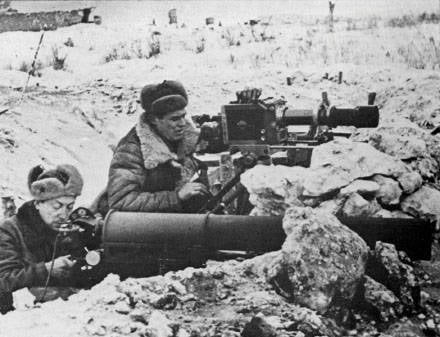
By the way, the idea of organizing the filming of a film about the Battle of Moscow belonged to Stalin. At the end of November 1941, he called Chairman Goskino I. Bolshakov from Central Asia and told him: “We are going to strike the Germans with a huge force. I think that they will not stand it and will roll back ... It is necessary to film it all and make a good film. ” And he demanded to personally report to him on the preparation and the course of the shooting.
By the beginning of the Soviet counter-offensive, front-line cameramen were sent to almost all the advancing armies. In conditions of severe frosts, when the camera mechanisms froze and due to snow drifts, one had to make long transitions on skis and on foot with a load of equipment on his shoulders, thousands of meters of the film were quickly received from the front.
The film's director, Ilya Kopalin, recalled: “These were harsh but joyful days. We created the film in front-line combat ... At night, we discussed the tasks with the operators the next day, and in the morning the cars took the operators to the front. In the evening, they returned with footage. The shooting was very hard. There were cases when the body of the deceased comrade and broken equipment lay in the car returning from the front. But the consciousness that the enemy is rolling away from Moscow ... gave strength. ”
The cameramen filmed the first settlements recaptured from the enemy: Venev, Mikhailov, Epifan, Klin, Rogachev, the first trophies of the Soviet troops, abandoned German equipment and the corpses of the "conquerors" in roadside ditches. For the first time on the screen opened the face of fascism. The charred corpses of prisoners of war, shot partisans, burning houses, the gallows in Volokolamsk, the blown-up New Jerusalem Monastery; the ruined house-museum of Leo Tolstoy in Yasnaya Polyana, the half-burnt house of Tchaikovsky in Klin ...
The film was promptly assembled by January 12 1942 and was shown to Stalin. After making all his amendments, it was printed in the number of 800 copies and is shown on the day of the 24 anniversary of the Red Army. The picture immediately gained recognition, becoming the documentary evidence of the first major Soviet victory, dispelling the myth of the invincibility of the German army.
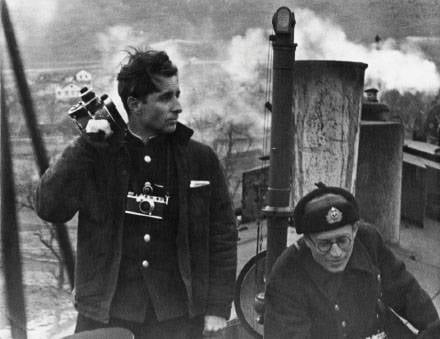
The film caused a huge political resonance abroad, where it was shown in 28 countries. In America and England alone, over 1,5 million viewers saw the film in 16 thousand movie theaters. He confirmed the vitality of the Soviet state and became a watershed in assessing the forces of the Red Army in the West. Stalin, who really liked the film, often showed it to foreign guests. After one of the views he remarked: “One good film is worth several divisions.” It is not surprising that the tape was awarded not only the Stalin Prize, but also for the first time in the history of the American Film Academy. The names of military operators, the authors of the film, forever went down in the history of domestic, and indeed world cinema. These are I. Belyakov, G. Bobrov, T. Bunimovich, P. Kasatkin, R. Carmen, A. Krylov, A. Lebedev, B. Makaseev, B. Nebylitsky, V. Soloviev, M. Shneiderov, V. Shtatland, S Cher, A. Schekutiev, A. Elbert, I. Sokolnikov, M. Sukhova.
Together with the soldier
Konstantin Simonov, who himself went through the war, wrote about military operators: “Looking at the rear of front-line newsreels, people do not always clearly understand what it means to work with a movie camera in the context of a modern war, what is one or another seemingly not particularly outwardly effective frame films. It is almost always worth the effort. ”
Of course, the cinematographer’s mission in the war was not the hardest, but like any other, it required tremendous courage, self-control and the highest professionalism and, by virtue of its uniqueness, requires a more detailed story. The parts commanders sent the operators to the front-line operators at the site of interest, where they were already united in three faces - the scriptwriters, directors and cameramen, deciding on the spot who to shoot and how. This was also required by Soyuzkinozhurnal: that the material should be a complete story about the event. It was here that the “paired” method of work was most effectively used, when one operator was shooting general plans, the other larger ones, by the way, the camera set an aperture and focus on the eye on the cameras of that time. There is already limited creativity creativity. After all, the Aimo camera cassette contained just 30 meters — one minute of screen time, and the spring, almost like a gramophone, had enough plant for only half a minute. After taking a minute, you had to stick your hands with a cassette into a dark bag, reload it, wrap the film in black paper, insert the cassette and work further. And God forbid, at this moment, a speck fell on the film - at the studio during development, the material immediately went to the marriage.
The main weapon of the Soviet cameramen camera "Aimo" was another constructive feature, highly appreciated at the front. In the lens hood 75 mm with a screwed-on filter included 40 g of alcohol from the emergency supply for wiping lenses. It will seem strange, but then the operators practically did not watch their material on the screen, and very often they saw it only after the war. The material was sent to Moscow by plane and was accompanied by a mounting sheet, which was filled by the operator, where he explained the shot. In response to each material came a review from Moscow editors. It is not difficult to imagine how the operators M. Schneider and I. Panov laughed when they shot the famous shots with hoisting the Victory Banner over the Reichstag when they received the following instruction from the review editors: “Rematch marriage!”. By the way, these were staged cadres, because, alas, the Reichstag storming itself took place at night, but these cadres became known to the whole world, becoming a symbol of our Victory. But what to say, during the war many operators sinned with staging shots, but what could they do if the leadership demanded “combat” scenes, and the front was in deep defense, for example. And the majority of operators shot the war next to the soldier in the very center of the battle, from the trench at the forefront as the front-line soldiers saw it ...
Enemies and allies
But on the other hand, the enemy side also shot the war. In the Wehrmacht, in each army group, so-called propaganda companies were organized, consisting of writers, artists, journalists and cameramen. Total on the Eastern Front operated around 17 such mouths. Sometimes they were given to the advancing units in squad. So, in December, 1941 acted as a platoon with eight cameramen and photographers during the SS division “Dead Head”. It is interesting to note that in the days of the Soviet counter-offensive, a report from the eastern front disappeared from the screens of Hitler Germany, and the press published a statement by the Ministry of Propaganda that there were severe frosts in Russia, especially near Moscow, which impeded the work of the film cameras.
Filming of German cameramen were in the nature of film drawings. Their work, especially in the early years of the war, was to show the superiority of the German soldier. Thanks to the shooting of German operators, real cadres of defeats of the Red Army at the beginning of the war have reached us: columns of prisoners, broken machinery, captured cities. German operators were much better technically prepared, having armed with the “Arriflex” movie camera with electric drive and tapes on 60 and sometimes 120 m, and closer to the end of the war a color film.
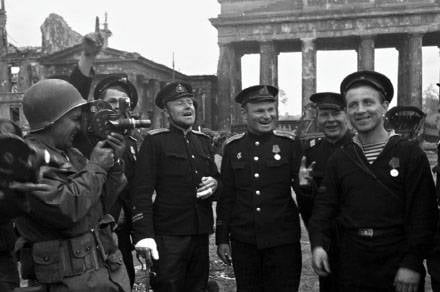
In the US Army, all cameramen joined the signal corps, which was responsible for all the footage shot at the front and singled out separate signal companies right in the division. At the end of 1942 in California in Culver City, a school of military cameramen and photographers was organized at the Hal Roach studio, where more than 1500 people were trained during the war years. This allowed, for example, more than 6 operators to land an 1944 June 200 landing in Normandy, while at the same time no more than 150 worked on the entire Soviet-German front. During the campaign in the Pacific, American commanders distributed movie cameras to ordinary soldiers, and unique movie shooters reached us. At the end of the war, this American experience was creatively used by the director of the film group of the 3 of the Belarusian Front, director A. Medvedkin, who offered to recruit operators from sergeants who showed themselves well in battles. For them, they opened a special school and armed 16-mm movie cameras with a PCA trigger. These 30 "kinoavtomatschikov" managed to shoot a lot of combat newsreels, which hit the film "Sturm Koenigsberg" and "Berlin."
In the lens of the war
And if the battle for Moscow became a turning point in the minds of the Soviet people, who finally believed that the enemy could still be beaten, then after the film “The defeat of the German troops near Moscow” a turning point also occurred in the work of the Soviet frontline cameramen. Having received world recognition, they began to work more confidently and meaningfully. Seeing at what cost victory was achieved, people understood that it was the Soviet soldier, who stood up in defense of his homeland, is the main hero of the war.
Suffering with Leningraders from hunger, cold, bombings, the operators A. Bogorov, A. Pogorely, V. Strasin, E. Uchitel, G. Zakharova and others managed to capture the tragedy and blockade of Leningrad in the film “Leningrad in the Fight”. With swollen legs, head spinning from hunger, they still went out into the street and at the limit of human forces continued to shoot.
All 250 days of defense of Sevastopol alongside defenders of the city were the operators V. Mikosha, D. Rymarev, K. Ryashentsev, A. Krichevsky, A. Smolka, and others, who continued to keep the movie film of the heroic defense in the film “Black Sea”.
In the summer of 1942, Soviet cinematographers set about shooting a grand, as they say now, project. 160 operators at the same time, on the same day all along the front line from the Barents Sea to the Black Sea, and also filmed in the rear, how the 356 day of the war flowed, namely 13 June 1942. The film, which appeared on the screens of the country in September under the name “Day of War”, became a snapshot of the country's face at the moment of its deadly clash with the enemy. This tape played a huge role in the course of the Stalingrad battle and the battle for the Caucasus.
For six months in a row, starting in August 1942 and up to the last salvo at the beginning of February 43, the front-line operators B. Waqar, N. Viirev, I. Malov, V. Orlyankin, M. Poselsky, B. Shadronov and dr. Orlyankin, who managed to shoot scenes of battles with a stationary camera in Stalingrad, was particularly distinguished during the shooting. How he stayed alive at the same time, only God knows. The film “Stalingrad”, released on 1943 screens, became a real sensation. So, Churchill 28 March 1943, in his message to Stalin, said: “Last night I saw the film“ Stalingrad ”. It is truly grandiose and will make the most exciting impression on our people. ”
At the beginning of 1943, the idea of shooting a film about the struggle behind enemy lines was born in the Central Headquarters of the partisan movement. Operators N. Bykov, I. Veinerovich, M. Glider, B. Makaseev, M. Sukhova, S. Shkolnikov and others were transferred by various routes, most often with a parachute, behind the front line. Personnel shot by them in Karelia, Belarus, Ukraine , in the Crimea, near Leningrad and Bryansk, entered the film "People's Avengers".
The liberation of the Soviet territory, which began after the Battle of Kursk, was reflected in the films “Battle of Oryol” and “Battle for our Soviet Ukraine”. Now, along with the filming of our heroic victories, the responsibility of the operators to capture the more and more revealing realities of the Nazi occupation fell on the shoulders of the operators. Here, operators R. Geek, A. Solodkov, M. Prudnikov, A. Sofin, S. Semenov, V. Smorodin, S. Urusevsky and many others performed well.
Soviet front-line operators seemed to have firmly taken their place in documentary films. A department of front-line film groups was formed, a film group was created under the Air Force, and the entire decoding and systematization of film material was entrusted to a special department of film chronicles of the Great Patriotic War.
But the operator "freemen" did not like Stalin. When the victory was close, the “father of nations” no longer needed the trench truth about the war, with its losses in people and technology, because it was he who had to remain the main, great director of the victory. And in May, 1944 was dismissed by a secret decree of the Glavkinohronika, the issue of SoyuzkinLogazine was discontinued, instead of it they began to issue “News of the day ”and specialized“ Front-level kinovypuski ”. Stalinist troops in documentary films were made by venerable filmmakers from the cinema film S. Gerasimov, A. Zarkhi, I. Kheifits, A. Dovzhenko, Yu. Raizman. With their arrival, the main emphasis was placed on creating monumental epics about large-scale victories of the Red Army under the “wise Stalinist leadership”, about the “ten Stalinist strikes” ...
But front-line operators marched west with the Red Army. And it is not their fault that the filmed material was subjected to targeted distortion. The leadership needed only bright victories captured by courageous operators: “Victory in Right-Bank Ukraine”, “Liberation of Soviet Belorussia”, “Victory in the North”, “Victory in the South”, “From the Vistula to the Oder”, “Budapest”, “Koenigsberg” , "Berlin". Before the start of the Berlin operation, the Central Operational Film Group was created, which made it possible to send 38 operators to all crucial battlefields. In Berlin itself, the last footage of the Great Patriotic War and the great moments of the 20th century were shot: storming the Reichstag, signing the German surrender act 9 in May 1945 ... The logical continuation of the front-line work was the shooting of the grand Victory Parade on Red Square in June 24 1945, which were shot more than 45 cameramen, including the trophy color film, shown, incidentally, in defeated Berlin.
Film report from ... hell
“... The main task of the military operator is to make a film report from the earthly hell. It is necessary to remove the critical moments of the battle and turn them into a work of art, ”cameraman Vladimir Sushchinsky, who died in 1945 during the shooting in Breslau, wrote in a letter. And through this hell passed 282 Soviet cameraman. They retreated, defended, attacked, partisans, liberated cities and villages, churned up the dirt of front-line roads, filmed both in cold and heat. They were always close to the soldier, be it an infantryman, an artilleryman, a scout, a tankman, a sailor, a partisan, wounded in a hospital, or a worker at the bench in the rear.
But war does not happen without losses, every second front-line operator was wounded, and every fourth was killed. In 1941, the cinema group of the South-Western Front went missing near Kiev, the Baltic cinema group died on the transport “Vironiya” fleet. Five classmates V. Suschinsky, V. Muromtsev, N. Pisarev, V. Vysotsky, N. Nomofilov did not return from the war. With a camera in their hands M. Sukhova, B. Vakar, N. Bykov, S. Stoyanovsky, A. Elbert, A. Shilo, I. Malov, Y. Leibov, P. Lamprecht, A. Znamensky, B. Pumpyansky, I Averbakh, V. Krylov, M. Kapkin, G. Rodnichenko and others.
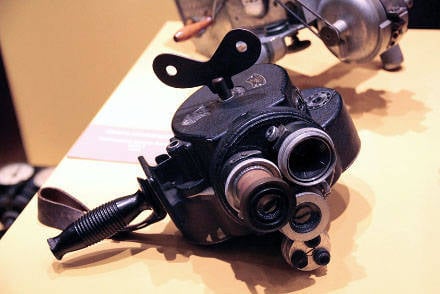
And many exploits were performed by front-line operators: N. Kovalchuk and his assistant left the encirclement for 25 days, A. Saffron escaped from German captivity, B. Sher shot down the “fokker” during shooting from the attack aircraft, and N. Lytkin got the order of Glory when he got into the penal battalion 3rd degree, E. Lozovsky was seriously injured, experiencing an armored cap for shooting from tank, A. Yeshurin, S. Shkolnikov personally participated in partisan battles. Two orders of the Red Banner were awarded to A. Krylov, together with male operators, women worked - M. Sukhova, O. Reizman, G. Zakharova ... "The enormity of their work corresponded to the enormity of the war," Konstantin Simonov wrote about front-line operators.
Two frontline cameramen of the Great Patriotic War are still alive and well. They are Semen Semenovich Shkolnikov, who was still shooting the Finnish war and now living in Tallinn (he turned 95 years old in January of this year), and Muscovite Boris Aleksandrovich Sokolov, who also exceeded 90. Eternal glory to them and low bow for invaluable shots of the people's feat.
Guild of cameramen SK of Russia
Photo from the archive of the author
Information